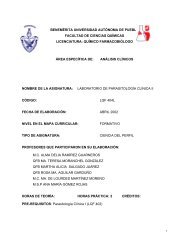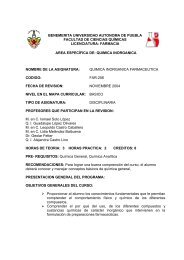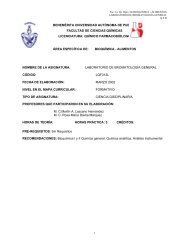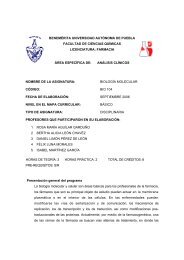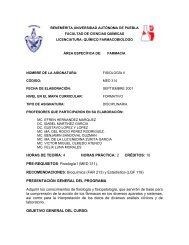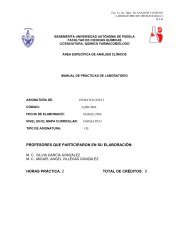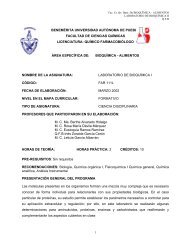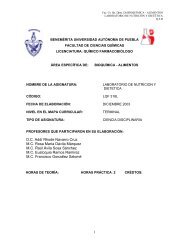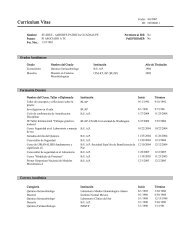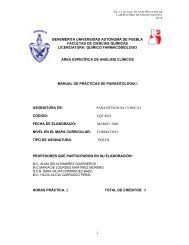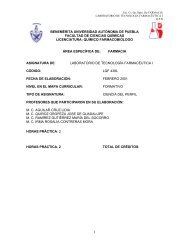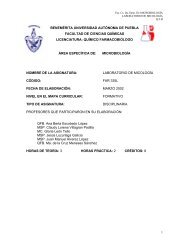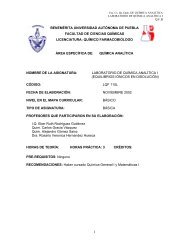programa de renovación y retención de la planta docente de la ...
programa de renovación y retención de la planta docente de la ...
programa de renovación y retención de la planta docente de la ...
You also want an ePaper? Increase the reach of your titles
YUMPU automatically turns print PDFs into web optimized ePapers that Google loves.
PROGRAMA DE RENOVACIÓN Y RETENCIÓN DE LA PLANTA<br />
DOCENTE DE LA FACULTAD DE CIENCIAS QUÍMICAS.<br />
En el mes <strong>de</strong> noviembre <strong>de</strong> 2005 se aprobó el P<strong>la</strong>n <strong>de</strong> Desarrollo <strong>de</strong> <strong>la</strong><br />
Facultad para el periodo 20052009, en éste se presentan <strong>la</strong>s acciones a<br />
realizar en los rubros <strong>de</strong> docencia, investigación, extensión y vincu<strong>la</strong>ción. Para<br />
ello se conformaron diferentes comisiones, una <strong>de</strong> el<strong>la</strong>s es <strong>la</strong> comisión para <strong>la</strong><br />
<strong>retención</strong> y <strong>renovación</strong> <strong>de</strong> <strong>la</strong> p<strong>la</strong>nta académica. Ésta se encuentra integrada por<br />
los jefes <strong>de</strong> <strong>la</strong>s áreas específicas, los responsables <strong>de</strong> los Cuerpos<br />
Académicos (CA), los miembros <strong>de</strong> <strong>la</strong> comisión <strong>de</strong> p<strong>la</strong>neación <strong>de</strong>l CUA y los<br />
secretarios <strong>de</strong> p<strong>la</strong>neación, académico y <strong>de</strong> investigación.<br />
Es <strong>de</strong> relevante importancia avanzar para contar en un mediano p<strong>la</strong>zo<br />
con un <strong>programa</strong> institucional <strong>de</strong> permanencia voluntaria para el personal<br />
académico en situación <strong>de</strong> jubi<strong>la</strong>ción (Programa <strong>de</strong> Retención), a fin <strong>de</strong><br />
<strong>de</strong>sacelerar el proceso <strong>de</strong> crecimiento <strong>de</strong> jubi<strong>la</strong>dos.<br />
OBJETIVO DE LA COMISIÓN:<br />
ESTRATEGIAS:<br />
METAS:<br />
• Mantener y fortalecer <strong>la</strong> calidad académica <strong>de</strong> los PE <strong>de</strong> <strong>la</strong><br />
Facultad <strong>de</strong> Ciencias Químicas.<br />
• Realizar un diagnóstico <strong>de</strong> <strong>la</strong> p<strong>la</strong>nta académica en re<strong>la</strong>ción a <strong>la</strong><br />
jubi<strong>la</strong>ción.<br />
• Revisar <strong>la</strong> normatividad existente al respecto.<br />
• Discusión plural y colegiada.<br />
• Contar con un <strong>programa</strong> <strong>de</strong> <strong>retención</strong> y <strong>renovación</strong> <strong>de</strong> <strong>la</strong> p<strong>la</strong>nta<br />
académica <strong>de</strong> <strong>la</strong> Facultad.<br />
• Realizar <strong>la</strong> gestión ante <strong>la</strong>s autorida<strong>de</strong>s.<br />
1
RESULTADOS DEL TRABAJO DE LA COMISIÓN:<br />
• La jubi<strong>la</strong>ción <strong>de</strong> profesores en el periodo 20062009 se pue<strong>de</strong> convertir<br />
en un problema estructural pues en ese periodo tendrán posibilidad <strong>de</strong><br />
jubi<strong>la</strong>rse el 56% (62/110) profesores <strong>de</strong> tiempo completo. (se anexa<br />
diagnóstico)<br />
• La normatividad al respecto (RIPPPA y Ley orgánica) es muy general y<br />
no contemp<strong>la</strong> los aspectos <strong>de</strong> <strong>retención</strong> y <strong>renovación</strong> <strong>de</strong> <strong>la</strong> p<strong>la</strong>nta<br />
académica.<br />
• Existe un alto porcentaje <strong>de</strong> profesores <strong>de</strong> tiempo completo jubi<strong>la</strong>bles<br />
con disposición a seguir trabajando en <strong>la</strong> institución. (se anexan<br />
resultados <strong>de</strong>l instrumento aplicado).<br />
• Como resultado <strong>de</strong>l diagnóstico se <strong>de</strong>terminó el número aproximado <strong>de</strong><br />
profesores y el periodo en que se jubi<strong>la</strong>rán en <strong>la</strong>s diferentes áreas<br />
específicas. A<strong>de</strong>más se presentó <strong>la</strong> ten<strong>de</strong>ncia <strong>de</strong> <strong>retención</strong> <strong>de</strong> los<br />
mismos<br />
• Se presentó el número <strong>de</strong> profesores por área específica y el año en que<br />
<strong>de</strong>berán ser repuestos <strong>de</strong>bido a <strong>la</strong> jubi<strong>la</strong>ción.<br />
OPINIONES FINALES DE LOS MIEMBROS DE LA COMISIÓN:<br />
• La jubi<strong>la</strong>ción según <strong>la</strong> ley fe<strong>de</strong>ral <strong>de</strong>l trabajo es un <strong>de</strong>recho <strong>de</strong> los<br />
trabajadores y una obligación <strong>de</strong> <strong>la</strong> institución.<br />
• Se <strong>de</strong>berá proponer un perfil <strong>de</strong>l profesor a retener.<br />
• Que exista un instrumento <strong>de</strong> evaluación para <strong>la</strong> <strong>retención</strong> <strong>de</strong><br />
profesores.<br />
• Los profesores que cump<strong>la</strong>n con el perfil reciban compensación<br />
económica.<br />
• Que <strong>la</strong>s áreas analicen y discutan otros estímulos en <strong>la</strong> <strong>retención</strong>.<br />
• Aplicación <strong>de</strong> un instrumento <strong>de</strong> evaluación diagnóstica para conocer el<br />
or<strong>de</strong>n en que se <strong>de</strong>berán recategorizar los profesores.<br />
2
ANEXOS<br />
DIAGNÓSTICO DEL POTENCIAL DE JUBILACIÓN DE LA PLANTA ACADÉMICA DE LA<br />
30<br />
25<br />
20<br />
% 15<br />
10<br />
5<br />
0<br />
29<br />
FACULTAD CONSIDERANDO EL PERIODO 20062009.<br />
Ten<strong>de</strong>ncia <strong>de</strong> jubi<strong>la</strong>ción<br />
General <strong>de</strong> <strong>la</strong> Facultad <strong>de</strong> los 141 profesores<br />
Como es posible observar <strong>la</strong> ten<strong>de</strong>ncia <strong>de</strong> jubi<strong>la</strong>ción <strong>de</strong> <strong>la</strong> p<strong>la</strong>nta<br />
académica <strong>de</strong> <strong>la</strong> Facultad en general se convertirá en un problema estructural<br />
en los próximos años dado que si así lo <strong>de</strong>cidieran los profesores para el 2009<br />
más <strong>de</strong>l 60% <strong>de</strong> <strong>la</strong> p<strong>la</strong>nta estaría jubi<strong>la</strong>da. Para analizar el problema con más<br />
<strong>de</strong>talle se presentó el diagnóstico <strong>de</strong> cada área específica <strong>de</strong> <strong>la</strong> Facultad<br />
teniendo lo siguiente:<br />
9<br />
12<br />
2006 2007 2008 2009<br />
40<br />
35<br />
30<br />
25<br />
% 20<br />
15<br />
10<br />
5<br />
0<br />
37<br />
8<br />
Ten<strong>de</strong>ncia <strong>de</strong> Jubi<strong>la</strong>ción<br />
PTC (110 profesores)<br />
7<br />
2006 2007 2008 2009<br />
11<br />
7<br />
3
10.0%<br />
9.0%<br />
8.0%<br />
7.0%<br />
6.0%<br />
5.0%<br />
4.0%<br />
3.0%<br />
2.0%<br />
1.0%<br />
0.0%<br />
60.0%<br />
50.0%<br />
40.0%<br />
% 30.0%<br />
20.0%<br />
10.0%<br />
0.0%<br />
Ten<strong>de</strong>ncia <strong>de</strong> Jubi<strong>la</strong>ción<br />
Físico Matemáticas (10 profesores)<br />
10%<br />
0.0%<br />
10%<br />
2006 2007 2008 2009<br />
60%<br />
10%<br />
60.0%<br />
50.0%<br />
40.0%<br />
30.0%<br />
20.0%<br />
10.0%<br />
0.0%<br />
Ten<strong>de</strong>ncia <strong>de</strong> Jubi<strong>la</strong>ción<br />
Química General (5 profesores)<br />
Ten<strong>de</strong>ncia <strong>de</strong> Jubi<strong>la</strong>ción<br />
Química Analítica (9 profesores)<br />
56%<br />
0.0% 0.0% 0.0%<br />
2006 2007 2008 2009<br />
0.0%<br />
11%<br />
2006 2007 2008 2009<br />
0.0%<br />
4
50.0%<br />
45.0%<br />
40.0%<br />
35.0%<br />
30.0%<br />
% 25.0%<br />
20.0%<br />
15.0%<br />
10.0%<br />
5.0%<br />
0.0%<br />
35.0%<br />
30.0%<br />
25.0%<br />
20.0%<br />
%<br />
15.0%<br />
10.0%<br />
5.0%<br />
0.0%<br />
Ten<strong>de</strong>ncia <strong>de</strong> Jubi<strong>la</strong>ción<br />
Química Orgánica (19 profesores)<br />
47%<br />
5%<br />
0.0% 0.0%<br />
2006 2007 2008 2009<br />
32%<br />
11%<br />
%<br />
40.0%<br />
35.0%<br />
30.0%<br />
25.0%<br />
20.0%<br />
15.0%<br />
10.0%<br />
5.0%<br />
0.0%<br />
Ten<strong>de</strong>ncia <strong>de</strong> Jubi<strong>la</strong>ción<br />
Físico Química (19 profesores)<br />
21%<br />
2006 2007 2008 2009<br />
Ten<strong>de</strong>ncia <strong>de</strong> Jubi<strong>la</strong>ción<br />
Química Inorgánica (8 profesores)<br />
38%<br />
0.0%<br />
13%<br />
2006 2007 2008 2009<br />
11%<br />
13%<br />
5
20.0%<br />
18.0%<br />
16.0%<br />
14.0%<br />
12.0%<br />
10.0%<br />
%<br />
8.0%<br />
6.0%<br />
4.0%<br />
2.0%<br />
0.0%<br />
25.0%<br />
20.0%<br />
15.0%<br />
10.0%<br />
5.0%<br />
0.0%<br />
Ten<strong>de</strong>ncia <strong>de</strong> Jbi<strong>la</strong>ción<br />
Microbiología (16 profesores)<br />
13% 13%<br />
19%<br />
2006 2007 2008 2009<br />
21%<br />
7%<br />
%<br />
16.0%<br />
14.0%<br />
12.0%<br />
10.0%<br />
8.0%<br />
6.0%<br />
4.0%<br />
2.0%<br />
0.0%<br />
Ten<strong>de</strong>ncia <strong>de</strong> Jubi<strong>la</strong>ción<br />
BioquímicaAlimentos (14 profesores)<br />
0.0%<br />
16%<br />
2006 2007 2008 2009<br />
0.0%<br />
Ten<strong>de</strong>ncia <strong>de</strong> Jubi<strong>la</strong>ción<br />
Farmacia (19 profesores)<br />
5% 5%<br />
2006 2007 2008 2009<br />
7%<br />
16%<br />
6
18.0%<br />
16.0%<br />
14.0%<br />
12.0%<br />
10.0%<br />
%<br />
8.0%<br />
6.0%<br />
4.0%<br />
2.0%<br />
0.0%<br />
18%<br />
Ten<strong>de</strong>ncia <strong>de</strong> Jubi<strong>la</strong>ción<br />
Análisis Clínicos (17 profesores)<br />
12%<br />
2006 2007 2008 2009<br />
En general, como se pue<strong>de</strong> observar <strong>de</strong> los gráficos anteriores, al<br />
termino <strong>de</strong>l periodo 20062009 <strong>la</strong> situación <strong>de</strong> jubi<strong>la</strong>ción se torna difícil y<br />
complicada, en especial para <strong>la</strong>s áreas <strong>de</strong> Química Analítica, Química General,<br />
Química Orgánica, Química Inorgánica y Físico Química en don<strong>de</strong> al final <strong>de</strong>l<br />
periodo mencionado se podría llegar en todas a más <strong>de</strong> 50% <strong>de</strong> profesores<br />
jubi<strong>la</strong>dos y en especial en Físico Química con un 75%. Para <strong>la</strong>s áreas <strong>de</strong> Físico<br />
Matemáticas, Microbiología, Farmacia, BioquímicaAlimentos y Análisis<br />
Clínicos al final <strong>de</strong>l periodo sería entre el 30% y el 45% situación que <strong>de</strong><br />
ninguna manera es tampoco ha<strong>la</strong>gadora.<br />
6%<br />
0.0%<br />
7
TENDENCIA DE RETENCIÓN Y JUBILACIÓN DE LA PLANTA ACADÉMICA DE LA FACULTAD<br />
Área espoecífica<br />
DE CIENCIAS QUÍMICAS<br />
2006 2007 2008 2009 Total<br />
Química Analítica 9 6 5 1 1<br />
Microbiología 15 6 5 1 1<br />
Bioquímica<br />
Alimentos<br />
Físico<br />
Matemáticas<br />
15 6 5 1 1<br />
10 4 2 1 1 2<br />
Análisis Clínicos 17 6 5 1 1<br />
Farmacia 19 7 5 1 1 2<br />
Química<br />
Inorgánica<br />
8 5 5<br />
Químca General 5 3 2 1 1<br />
Físico Química 19 14 11 1 1 1 3<br />
Química Orgánica 19 9 8 1 1<br />
Total <strong>de</strong> <strong>la</strong>s<br />
Áreas especificas<br />
Total <strong>de</strong><br />
profesores<br />
Profesores jubi<strong>la</strong>bles<br />
en 20062009<br />
Profesores<br />
que<br />
<strong>de</strong>searían<br />
retenerse<br />
Profesores que <strong>de</strong>searían Jubi<strong>la</strong>rse<br />
136 66 53 1 5 4 3 13<br />
8
RENOVACIÓN<br />
En <strong>la</strong> siguiente tab<strong>la</strong> se presenta <strong>la</strong> propuesta <strong>de</strong> <strong>renovación</strong> <strong>de</strong><br />
profesores en <strong>la</strong> Facultad <strong>de</strong> Ciencias Químicas consi<strong>de</strong>rando el área <strong>de</strong><br />
adscripción, el número <strong>de</strong> profesores y el año en el que se <strong>de</strong>berán renovar:<br />
Áreas específicas<br />
Periodo<br />
2006 2007 2008 2009 Total<br />
Categoria<br />
Química Analítica 1 1 PI ASOCIADO B T.C<br />
Microbiología 1 1 PI ASOCIADO B T.C<br />
Físico Matemáticas 1 1 2<br />
PI ASOCIADO B T.C.<br />
PI ASOCIADO C T.C<br />
Análisis Clínicos 1 1 PI ASOCIADO B T.C<br />
BioquímicaAlimentos 1 1 PI ASOCIADO B T.C.<br />
Farmacia 1 1 2<br />
PI ASOCIADO C T.C.<br />
PI ASOCIADO C T.C<br />
Química General 1 1 PI ASOCIADO C T.C.<br />
Físico Química 1 1 1 3<br />
PI TITULAR C T.C.<br />
PI TITULAR C T.C.<br />
PI ASOCIADO B T.C.<br />
Química Orgánica 1 1 PI TITULAR C T.C.<br />
Química Inorgánica 0<br />
Totales 1 5 4 3 13<br />
9
RETENCIÓN<br />
Estrategia: Discusión plural y colegiada.<br />
Como resultado <strong>de</strong> <strong>la</strong> discusión plural y colegiada <strong>de</strong> <strong>la</strong>s Áreas<br />
específicas y <strong>de</strong>l trabajo <strong>de</strong> <strong>la</strong> comisión, se tiene lo siguiente:<br />
El proceso <strong>de</strong> jubi<strong>la</strong>ción institucional se encuentra en una fase critica,<br />
consi<strong>de</strong>rando que aproximadamente el 60% <strong>de</strong> los académicos están en<br />
condiciones <strong>de</strong> jubi<strong>la</strong>rse lo que representaría <strong>la</strong> creación <strong>de</strong> nuevas p<strong>la</strong>zas que<br />
apegadas a <strong>la</strong> política <strong>de</strong> nuevas contrataciones correspon<strong>de</strong>ría a <strong>la</strong> categoría<br />
<strong>de</strong> titu<strong>la</strong>r y el grado <strong>de</strong> doctor. Esta situación llevaría a <strong>la</strong> institución a un<br />
problema estructural grave difícil <strong>de</strong> resolver satisfactoriamente. Por tal motivo<br />
el <strong>programa</strong> <strong>de</strong> <strong>retención</strong> voluntaria <strong>de</strong>l personal académico es un instrumento<br />
que <strong>de</strong>saceleraría significativamente el proceso <strong>de</strong> jubi<strong>la</strong>ciones, a<strong>de</strong>más <strong>de</strong><br />
mantener el potencial <strong>de</strong> habilitación con que cuenta actualmente <strong>la</strong> p<strong>la</strong>nta<br />
académica el cual representa uno <strong>de</strong> los soportes fundamentales en <strong>la</strong> calidad.<br />
Consi<strong>de</strong>raciones generales para el <strong>programa</strong> <strong>de</strong> <strong>retención</strong> voluntaria <strong>de</strong>l<br />
personal académico:<br />
PROPUESTAS:<br />
GENERALES<br />
• El <strong>programa</strong> <strong>de</strong> <strong>retención</strong> voluntaria <strong>de</strong>l personal académico <strong>de</strong>be ser un<br />
instrumento in<strong>de</strong>pendiente <strong>de</strong>l los procesos <strong>de</strong> recategorización, PIEVA<br />
y ESDEPED. Debido a que estos tienen metas y alcances distintos al<br />
pretendido en <strong>la</strong> <strong>retención</strong>.<br />
• El <strong>programa</strong> <strong>de</strong>be contener requisitos generales tales que todo el<br />
personal académico <strong>de</strong>finitivo y con <strong>la</strong> antigüedad necesaria, pueda<br />
acce<strong>de</strong>r a este.<br />
• El mecanismo para acce<strong>de</strong>r a dicho <strong>programa</strong> será <strong>la</strong> entrega <strong>de</strong>l<br />
currículo resumido, el cual será comprobado por el archivo institucional,<br />
junto con el Aval <strong>de</strong>l CUA:<br />
10
PARTICULARES<br />
• Se propone que el <strong>programa</strong> <strong>de</strong> <strong>retención</strong> contemple el otorgar un<br />
estimulo económico que sea el 50% <strong>de</strong>l sa<strong>la</strong>rio correspondiente a <strong>la</strong><br />
categoría <strong>de</strong>l profesor.<br />
• Que a los profesores próximos a jubi<strong>la</strong>rse se les <strong>de</strong> una compensación<br />
simi<strong>la</strong>r a <strong>la</strong>s horas c<strong>la</strong>se que atiendan según el tabu<strong>la</strong>dor vigente.<br />
• En el caso <strong>de</strong> los profesores cuya carga sea preferentemente<br />
investigación, se otorgue una compensación <strong>de</strong> un sa<strong>la</strong>rio mínimo a<br />
profesores con perfil PROMEP y si son miembros <strong>de</strong>l SNI una<br />
compensación mensual equivalente al 30% <strong>de</strong>l estímulo recibido por el<br />
SNI. (SNI 1 $2,100, SNI 2 $2,700, SNI 3 $4,500.00)<br />
• Que se les otorgue <strong>la</strong> ventaja <strong>de</strong> trabajar tiempo parcial, conservando su<br />
categoría <strong>de</strong> tiempo completo, es <strong>de</strong>cir que se les <strong>de</strong>scargue sus horas<br />
pizarrón a <strong>la</strong> mitad <strong>de</strong> <strong>la</strong>s solicitadas por contrato para un TC con <strong>la</strong><br />
salvedad que para <strong>la</strong> evaluación <strong>de</strong>l ESDEPED se consi<strong>de</strong>re que<br />
cubrieron el doble <strong>de</strong> horas que atendieron. Dando con ello <strong>la</strong> posibilidad<br />
<strong>de</strong> que estos profesores tengan mayor disponibilidad <strong>de</strong> tiempo para<br />
<strong>la</strong>bores <strong>de</strong> investigación y extensión.<br />
• Que en los instrumentos <strong>de</strong> evaluación para el otorgamiento <strong>de</strong><br />
estímulos al personal <strong>docente</strong> se contemple un rubro especial por cada<br />
trienio <strong>de</strong> trabajo <strong>la</strong>borado posterior a <strong>la</strong> fecha <strong>de</strong> jubi<strong>la</strong>ción, que<br />
signifique cuando menos un sa<strong>la</strong>rio mínimo por trienio, lo cual permitirá<br />
ampliar el monto <strong>de</strong>l estímulo por cada trienio <strong>la</strong>borado, asegurando <strong>la</strong><br />
estancia <strong>de</strong> al menos 6 años posteriores a <strong>la</strong> jubi<strong>la</strong>ción.<br />
Las organizaciones educativas <strong>de</strong>ben ser cuidadosas en evitar agrupar a<br />
todos los trabajadores mayores en <strong>la</strong> misma categoría, ya que el objetivo es<br />
atraer y conservar a los mismos, por lo tanto, es importante diferenciar <strong>la</strong>s<br />
experiencias <strong>la</strong>borales y <strong>la</strong>s motivaciones <strong>de</strong> estos empleados. Mientras<br />
que algunos tal vez están trabajando por razones financieras, otros ponen<br />
en primer lugar el sentirse comprometidos y hacer un trabajo que significa<br />
algo, por lo que se <strong>de</strong>berán consi<strong>de</strong>rar diferentes alternativas para estimu<strong>la</strong>r<br />
<strong>la</strong> <strong>retención</strong> <strong>de</strong> los profesores y así satisfacer ambas expectativas, <strong>la</strong>s <strong>de</strong><br />
estos y <strong>la</strong>s <strong>de</strong> <strong>la</strong> institución.<br />
11
CONCLUSIONES:<br />
• La <strong>retención</strong> y <strong>renovación</strong> <strong>de</strong> los profesores son un asunto prioritario en<br />
el contexto académico <strong>de</strong> <strong>la</strong> institución, esto es posible medirlo al hab<strong>la</strong>r<br />
<strong>de</strong> <strong>la</strong> capacidad y competitividad <strong>de</strong> los <strong>programa</strong>s educativos (PE),<br />
pues actualmente el contar con p<strong>la</strong>ntas académicas consolidadas y PE<br />
acreditados por organismos reconocidos como CIEES, COPAES y<br />
CONACyT permite asegurar <strong>la</strong> calidad <strong>de</strong> estos siendo reconocidos a<br />
nivel nacional y con ello facilitar <strong>la</strong> posibilidad <strong>de</strong> adquirir recursos para<br />
su <strong>de</strong>sarrollo. La Facultad <strong>de</strong> Ciencias Químicas es un ejemplo <strong>de</strong><br />
<strong>de</strong>sarrollo y consolidación tanto en el grado <strong>de</strong> habilitación <strong>de</strong> sus<br />
profesores como el nivel <strong>de</strong> calidad alcanzado <strong>de</strong> los PE.<br />
Todos los logros que han permitido tener PE acreditados se verían en<br />
riesgo si no se cuenta con en <strong>programa</strong> <strong>de</strong> <strong>retención</strong> y <strong>renovación</strong> <strong>de</strong> <strong>la</strong> p<strong>la</strong>nta<br />
<strong>docente</strong> que permita mantener y fortalecer <strong>la</strong> calidad académica que por<br />
muchos años han tenido los PE <strong>de</strong> esta Facultad.<br />
Aprobado el presente Programa, por el Consejo <strong>de</strong> Unidad Académica en su<br />
sesión ordinaria <strong>de</strong>l día 9 <strong>de</strong> noviembre <strong>de</strong> 2006<br />
12



